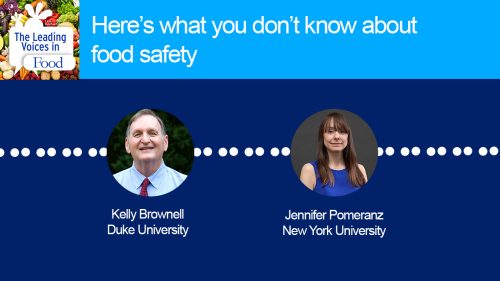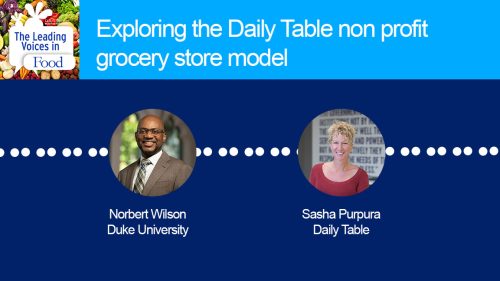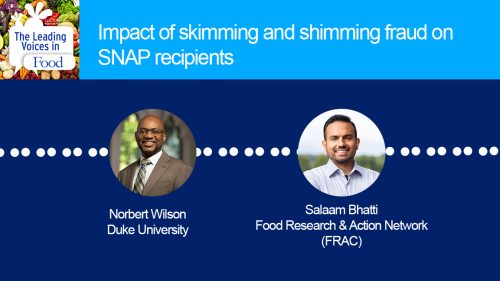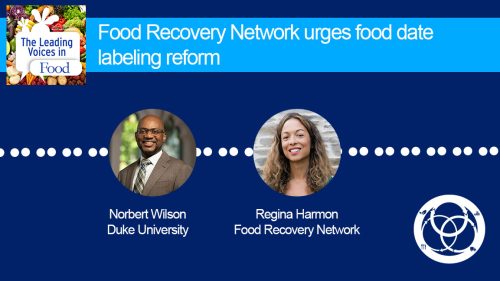The Leading Voices in Food
E230: Results from a national consumer attitudes survey on dollar stores
Dollar stores are the fastest growing food retailer in the United States, both by sheer number of stores and consumer food purchases. Just two corporations, Dollar General and Dollar Tree, which also owns Family Dollar, operate more than 35,000 stores across the country. However, a growing body of research reveals that dollar stores offer limited healthy food options. Dollar stores shape the food environments of communities, especially in the South and Midwest regions and communities in rural areas with substantial shares of Black and Latin people and households with limited financial resources. What do we know about the impact dollar stores have on these communities and the overall wellbeing of community members? The Center for Science in the Public Interest conducted a national survey to understand how people perceive and actually use dollar stores. Today we will talk with lead author of this study, Senior Policy Scientist Sara John.
Subscribe: Apple Podcasts | TuneIN | YouTube Music | SoundCloud | PocketCasts | Radio Public
Tags: Diet & Nutrition | Food Industry Behavior & Marketing | Food Insecurity |

Sara John is a Senior Policy Scientist at the Center for Science in Public Interest and leads the organization’s federal policy and private sector efforts to create a healthier, more equitable food retail environment. Prior to joining CSPI, Sara served as the Evaluation Director for SNAP incentive programs across New England and worked at the Partnership for a Healthier America. She has a PhD in Food Policy and Applied Nutrition from Tufts Friedman School, an MS in Education from Johns Hopkins University, and a BS in Biology and BA in Public Policy from University of North Carolina at Chapel Hill.
Interview Summary
My first question is what do we know about dollar stores and healthy food access?
There are more than 35,000-dollar stores across the country. So, to put that large number into context for people like me who have trouble processing them, that’s more dollar stores than McDonald’s, Starbucks and Walmarts combined. As you also mentioned, just two companies, Dollar General and Dollar Tree, control nearly all of them. Dollar stores really play a large role in food acquisitions for households. They can be especially important for households with limited incomes and those living in rural communities. These smaller store formats are much smaller than your typical grocery store or supermarket and tend to stock fewer fresh and healthy items. So, the body of evidence is still growing and we’re still trying to figure out really how dollar stores interact with the food environment, whether or not they’re driving out existing or potential new grocery stores or whether they’re filling important food gaps in communities that otherwise lack food access.
I am really blown away by the number. I must admit I did not appreciate that they have 35,000 stores across the US. I know that there is a growing body of literature, as you suggested. One of our colleagues, Sean Cash at Tufts has been working in this space along with others in various disciplines have been thinking about the role of dollar stores. I’m interested to understand why CSPI conducted a national survey of those or perceptions, and what were some of the key findings?
As I mentioned, there’s a lot of outstanding questions we still don’t know. There have been more than 50 communities across the country that have already passed policies at the local level to ban or improve new dollar stores in their communities. But we don’t understand community perceptions, usage and just I guess more plainly what people want from dollar stores. So, CSPI really wanted to take a stance to make policy, corporate, and research recommendations on this very quickly and growing retail format. But before doing so, we wanted to really make sure that we’re centering our recommendations around what community members really want from dollar stores. We decided to conduct a national survey. We ended up having over 750 respondents from across the country of people with limited financial resources that lived near a dollar store. I have to say we were pretty surprised by our findings, especially given this popular sentiment that we have seen in the news media and with a lot of the local policy action. I would say that we found overall positive dollar store perceptions that people really are relying on dollar stores for food. But I would say just as many people want them to make healthy foods more available, affordable, and accessible.
Could you help me understand how did people find them beneficial? What were some of the things that you discovered, in terms of the benefits? But I’d like to also hear what were the points of contention? Where did they want some difference?
Community members had overall positive perceptions. I think there was about 82% of the survey respondents said that dollar stores helped their community rather than harmed it. And a lot of the key things that came up in the qualitative responses in our survey and the focus groups that we used to inform the survey was this overarching multifaceted concept of convenience. People said things like the store proximity, that they didn’t have to walk a mile within the store itself to get to milk, and just an overall quick shopping trip. They also mentioned the affordability of products there. You know, not having to say no when shopping with their kids to something that’s on the shelf. And then also a selection of specialty items – a lot of like different seasonal fare and things. Even using the phrase “thinking of the dollar stores as like going on a treasure hunt.” You never quite know what’s going to be there on the shelves. However, as you mentioned, there was also many deterrents listed for dollar stores as well. Things they could do better. So, low quality of products, the lack of predictable product availability, sometimes having bare shelves or not enough store supervision to be able to keep those shelves stocked. And also, the store appearance, both inside and out. Things like graffiti, trash, cluttered aisles. Those are all things that people that both shopped and did not shop at dollar stores noted in the survey. And all of this also kind of leads to another key theme that I mentioned at an overarching level, that people really wanted dollar stores to do more in terms of making healthy foods more accessible to them. So, 81% of our survey respondents thought dollar stores should stock more healthy items, and nearly as many thought they should do more to market and identify healthy options. We also included a list of more specific interventions of things that dollar stores could do to make healthy products more available, accessible, and affordable and one of the top responses was to provide SNAP fruit and vegetable discounts, kind of as one might see in like a Schumacher Nutrition Incentive Program at dollar stores as well.
I’m really intrigued by something you all did in the survey. You looked at differences, particularly between SNAP participants and those who potentially are SNAP eligible, but non-participants. Are there any key findings you want to highlight about differences between those two groups?
Yes. Many respondents generally mentioned being able to stretch their budget at the dollar store and this included more SNAP participants purchasing more food with their SNAP benefits at dollar stores. So, this was across many healthy food categories. We also saw SNAP participants felt more strongly that dollar stores should be held more accountable for the health of their communities as well.
This is really fascinating. These findings are part of what leads you to some of the key policy recommendations. I’d be interested to understand a little bit more about what are the policies that you all thought should be considered or corporate response and even research action based on these findings.
I’ll highlight just a few. You know the first one at the federal level is strengthening SNAP retailer stocking standards. So, the vast majority of dollar stores do participate in the SNAP program and currently SNAP authorized retailers are required to stock a small number of items. So, three varieties of items across four different categories. However, if the SNAP program did have stronger stocking standards that better aligned with nutrition promoting foods like in the Dietary Guidelines for Americans, then all SNAP authorized retailers including dollar stores, would be required to stock more healthy items to participate in the program. Which is of course a huge benefit to the community. But also, a really important part of the business model of SNAP authorized retailers including dollar stores. At the local level, I already mentioned that more than 50 communities across the country have passed local policies, mostly to stop the spread of dollar stores such as through dollar store density ordinances. These look like saying a new dollar store can’t locate within, let’s say an existing mile, of a current dollar store. However, these policies are really only getting at new dollar stores and don’t really do anything to address the existing 35,000. We also see an opportunity to strengthen and improve upon these existing policies and address what we found in the survey that community members want by requiring dollar stores to stock healthier food, make it more available, such as through healthy stocking standards or healthy food overlays in the local zoning code or even exempting dollar stores from these dispersal limits if they do stock a specific variety or number of healthy staple foods. At the corporate level, we’re hopeful that this survey and its results make the business case to dollar stores for stocking healthier foods, making them more widely available. We’ve seen already actually both Dollar General and Dollar Tree moving in this direction. Dollar General, especially. I think about 16% of their current stores now do offer fresh produce. So, they’re building out their supply chain, their distribution centers, and I would say retrofitting and redesigning stores to be able to make more fresh and healthy foods available. But we think they can do more, and especially do more in terms of prioritizing fresh food expansion in areas with lower incomes and limited food access. Many of these dollar store models started by locating in rural areas. We think if they could really leverage their ubiquity and where they’re currently located to spread healthy food access to those communities especially, it could make a really big difference. We also have seen dollar stores in recent years put out public environmental social governance or ESG priorities. We think that these should be expanded and really prioritize healthy food access and nutrition goals. And one more thing I’ll say around corporate recommendations is the expansion of the Special Supplemental Nutrition Program for Women Infants and Children or WIC authorization of dollar stores. Currently, based on our scan of the current list of WIC authorized retailers, there are no corporate dollar stores that are currently WIC authorized. By participating in WIC, and by adhering to those much more rigorous healthy stocking standards, it could do a lot to make a variety of healthy product, fresh produce, whole grains, dairy, baby food, formula more accessible to moms and kids.
I have to ask this question as a researcher, what are some important questions that the survey really prompted you to think more about or would like to have others come in and support research in this area?
There are so many. As I mentioned, the evidence in this space is really nascent, but is growing. So, one thing I would highlight is that we really are proud of this survey and its national scope. However, the survey doesn’t reflect all communities and their desires and wishes. And so we hope that this survey could be used as a model and could be replicated in local communities to inform local policy and corporate intervention. We also think there’s a lot to still do to better understand the current dollar store food environment. There have been some studies that have been done at small scale in some states and localities, but we think that current instruments could be better adapted and specifically tailored to the dollar store environment to better understand them and their variation across the country. Especially as we start to see this shift in corporate practices. There is a lot of, again, variation in terms of different dollar stores and what they’re offering. We also really hope that we could see dollar store corporations, and maybe this is overly ambitious, but to collaborate with researchers to better understand what corporations already know, to better lift up what challenges are associated with increasing the stock and availability of healthier foods. We know that cost space and supply chain complexities, this is not an easy solution, and so how can researchers work together with corporate dollar stores to figure this out. Also, we’d be really interested in piloting healthy food marketing interventions, thinking about how this shift in healthy product placement, price and promotion might be impacting customer purchases, customer food consumption, and ultimately health.
Wow, this is a great set of ways for a variety of researchers to come in. It sounds like not only could academics do some of this work, but it sounds like there may even be space for citizen scientists to come in and look at what’s going on in the food environments where they are to help inform that conversation. I think this is really fascinating. What’s next for CSPI’s work on dollar stores.
CSPI really hopes to be able to support efforts to advance the recommendations we’ve made in this report. At least one I’ll highlight that we’ve already started to work on, is we just launched a corporate campaign; Don’t Discount Families, Dollar General. Really pressuring Dollar General to improve healthy food access at their stores through these WIC expansion efforts that I referenced earlier. So, making sure that dollar stores expand their healthy food offerings by adhering to those more rigorous WIC stocking standard requirements. Making those foods both available and more accessible to moms and kids participating in WIC. You know, that includes fresh, frozen, canned produce, whole grains, dairy, healthy pantry staples, baby food and formula, but also in doing so makes healthy foods more available for any customer that walks through a WIC authorized Dollar store. I would mention that in ways that you can get involved, please feel free to reach out to me if you’re doing aligned work in this space. We also have a petition that consumers can sign onto, and we already have generated over 7,000 emails to Dollar General and that number is still ticking, so please join our coordinated advocacy efforts and we also working on a sign-on letter in terms of coalition building to get organizations and researchers who are supporting healthy food access through dollar stores. So, I encourage everyone to check out our resources and again, please be in contact if you have any questions.









